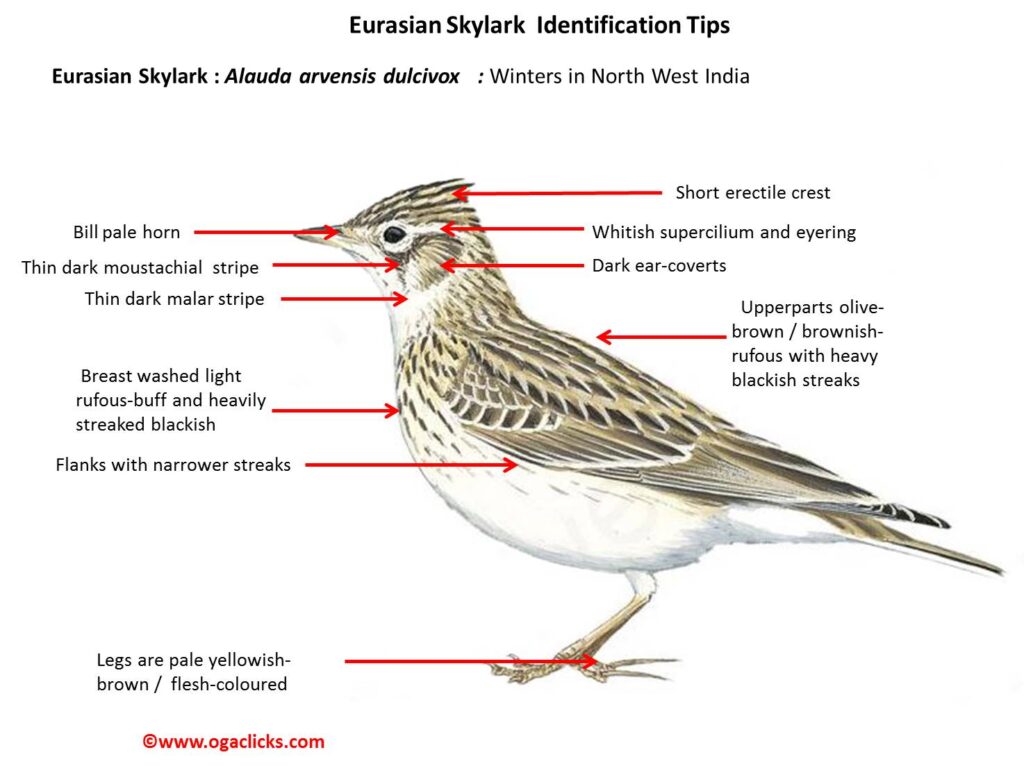
Eurasian Skylark Alauda arvensis dulcivox
Etymology:
- Alauda : Celtic name for lark meaning Great singer derived from al –great; aud –song.
- Arvensis: Latin word for Field derived from arvum – field
- Dulcivox : Latin word Dulcis– sweet, delightful; vox, vocis – voice
Vernacular Names : Hindi: Bharat
Distribution: Size of 16–19 cm; weight of male 35–50 g, weight of female 26–40 g. it is a medium-sized, fairly stout lark with shortish bill, fairly long wings with long primary projection in especially the migratory races, relatively long tail, short erectile crest. The nominate race has whitish supercilium and eyering, contrasting dark ear-coverts, indistinct thin dark moustachial and malar stripes. The crown and upperparts are variably olive-brown to brownish-rufous, heavily streaked blackish, nape is paler and less streaked. The wing-coverts are darker with broad pale fringes, but lesser coverts are paler and more buffish. The flight-feathers and tail dark brown to blackish with buffish edges, secondaries and inner primaries tipped white, outer rectrices white showing a prominent white trailing edge of inner wing and white tail side in flight. It is white to pale buff below, breast is washed light rufous-buff and heavily streaked blackish, flanks with narrower streaks; bill is pale horn; legs are pale yellowish-brown to flesh-coloured. Both the sexes are alike in plumage, female smaller than male. The juvenile has upperparts mottled buff and blackish with white edgings; breast more spotted than streaked.
Races differ mainly in size and overall plumage tone. The race dulcivox is winters in North West India & Ladakh. It is a distinctive, large, pinkish-buff above (greyish in worn plumage), streaks narrow.
Habitat: It is found in open habitats, farmland, heathland and moorland, meadows, grassland, steppe, edges of marshes, dunes, forest clearings. In non-breeding season found in arable land, cereal stubbles, and coastal habitats, including beaches. It is found from Sea-level 3000 m.
Food habits: It eats small invertebrates and seeds & other plant material. It is primarily insectivorous in breeding season and vegetarian in winter., insect larvae, beetles, grasshoppers, moths, spiders, flies, worms, molluscs, aphids & mites. It forages on the ground, singly or in pairs, outside breeding season found in small groups or large flocks. While foraging it walks and runs picking items from ground surface, sometimes digging, uprooting plants, picking items from plants. Kleptoparasitism has also been seen in them. It does not drink water.
Breeding habits: They breed in Mar/early Apr to Aug–Sept. They have up to four broods per season. They are Monogamous, male closely guards female prior to nesting; solitary & territorial, The Male has characteristic song flight, rising diagonally into wind with tail spread, wings fluttering, hovering for few minutes, then gliding downwards in spirals before sudden plummet to earth. The nest is built by female alone, a thick layer of grass, lined with finer vegetation, placed in excavated scrape or in natural depression on ground among short vegetation. They lay a clutch of 1–7 eggs . The incubation is done by female alone, from last egg for a period of 10–13 days. The chicks are fed by both parents. The nestling diet almost entirely invertebrates. The faecal sacs initially swallowed by parent, later removed and deposited away from nest. They leave nest at 8–10 days (when legs fully developed). The fledging period is 16–20 days.